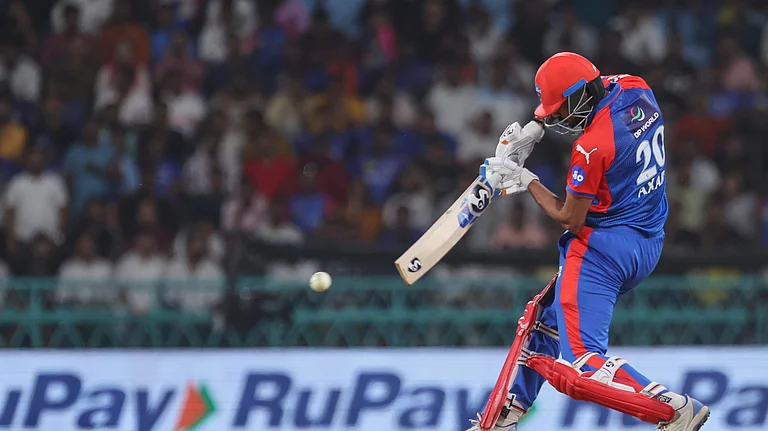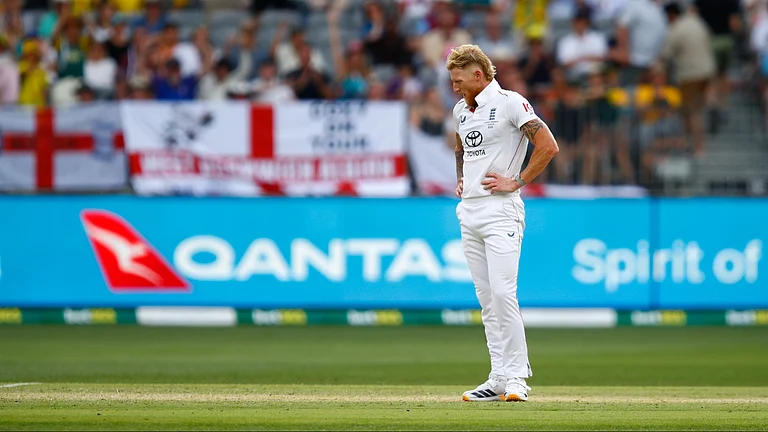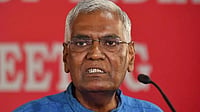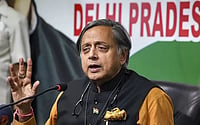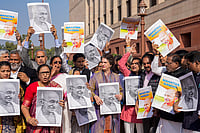SAIBAL CHATTERJEE ATLANTA 1996 was King Carl's Games. There were several sideshows—and resplendently glorious ones at that—authored by the likes of Michael Johnson and Haile Gebrselassie, but they will all almost certainly pale in comparison when, half a century or so from now, historians look back on the exploits of the peerless Carl Lewis, one of the most decorated Olympic athletes of all times.
But one development in Atlanta did match Lewis' long jump into history: the giant leap that the centennial Olympic Games represented for sportswomen. Atlanta 1996 witnessed the addition of a host of new disciplines for women—football, softball, the triple jump, the 5,000 m race, the 4X200 m relay in swimming, among other events. And the Games saw almost 3,000 female participants from 170 nations going for gold and glory. Only a select few succeeded, a large majority returned home empty-handed.
Perhaps, not quite. For, clearly, as numerous members of the 'weaker sex' stamped their undeniable class on the Atlanta Olympics, they won a major battle of the sexes. Women participants in the pool, on horseback, on the track and on the gymnastics floor exposed yet again, emphatically and triumphantly, the sheer fallacy of the sobriquet that they have had to live with for centuries. Weakness was a word that simply didn't exist in the lexicon of Atlanta's golden girls.
Indeed, the profile of the woman Olympian has changed. Asian and African women have seized their rightful place on the victory podium alongside the finest female athletes from Europe. The presumed timidity of yore has given way to an aggressive streak while clinical athletic craft has diversified into a deliberate mix of natural flair and feminine charm, even sex appeal. Women athletes, as photographers and sports writers worldwide will readily vouch, have not only got better by leaps and bounds, they have added much colour and beauty to sporting spectacles.
But that's only one side of the picture. The grit, the tenacity, the determination and the staying power that were on display in the women's sections in Atlanta were exemplary. Marathon gold medallist Fatuma Roba, a 25-year-old Addis Ababa policewoman, became the first African woman to win the marathon. Syria's Ghada Shouaa, who comes from a country which hitherto had only one silver medal (in heavyweight wrestling) at the Olympics, joined Jackie Joyner-Kersee and Heike Dreschler in the pantheon of heptathlon greats by picking up the gold.
Russian Svetlana Masterkova, an athlete who recently took a three-year break to have a child, sneaked past the favourite Maria Mutola of Mozambique and Ana Quirot of Cuba in the women's 800 m. Marie-Jose Perec, a tall, lissome part-time French model who is as sensuous as she is unbeatable, ran a fabulous 400 m to win her second successive Olympic gold in the event. Wang Junxia, a former Ma's army star who walked out of Junren's camp after winning the 10,000 m gold at the Stuttgart world championships in '93 and then struggled for three years to regain form, became the first 5,000 m woman gold medal-winner. US gymnast Kerri Strug defied injury and excruciating pain for one final vault that ensured a gold for her country in the women's team gymnastics competition.
Despite the strong showing by women during the '80s and '90s, a major part of Olympism's first century was dominated by men. In the first modern Olympics in 1896 in Athens, women were barred. In fact, Baron Pierre de Coubertin was opposed to their participation. It was only under International Olympic Committee (IOC) pressure that he relented: for the next three editions of the event, women competed in golf and tennis. Two disciplines and no more. Women, and the Olympics, have come a long way since then.
But the progress was painfully tardy. It wasn't until 1912 that women were allowed to participate in swimming. The most far-reaching breakthrough came in 1928 in Amsterdam: women made their first appearance on the track. But the longest distance they were allowed to run was 800 m. It nearly turned out to be a false start. The winner of the women's 800 m, Karoline Radke, collapsed at the end of the race. Sure enough, it sparked another debate about the feasibility of letting women participate in 'gruelling' events like the half-mile race. The then IOC president, Comte de Baillet-Satour, even suggested that the Olympic Games should go the ancient Greek way by keeping women out altogether.
Luckily, better sense prevailed. As it did in Atlanta this time round when a Swiss runner nearly passed out just before she completed the women's marathon. Women have in the intervening years achieved enough to keep the doubting Thomases at bay. The marathon for women was introduced in '84 at Los Angeles as was the heptathlon, which replaced the pentathlon. While the former event saw the emergence of American star Joan Benoit, the latter threw up Joyner-Kersee and Dreschler.
Sport is no longer a masculine preserve. Women like Wilma Rudolph, Nadia Comaneci, Steffi Graf, Florence Griffith-Joyner, Mary Slaney and Jackie Joyner-Kersee have made their marks. The first signs of change were seen in the '50s: women like swimmer Dawn Fraser at the Melbourne Games in '56 drew widespread media attention. Rudolph, Marita Koch, Slaney, a woman who, like Masterkova, reconciled motherhood and her pursuit of excellence; Valerie Brisco-Hookes, who won the 200 m-400 m double in '84; Olga Korbut, Mary-Lou Retton and Janet Evans, besides innumerable athletes, gymnasts and swimmers, kept up the good work.
But while occasional skirmishes have been won, the war is far from over. It's actually total parity between the two genders in terms of sporting implements, rules and, most importantly, the equal cash awards that women's bodies have been demanding for many years. There are miles to go before the sorties can be called off.
This being the 'Year of the Woman', women's events got near-equal air time on TV. And for the first time, the US women's teams held their own against the men in the medal tally. "For the first time, the US Olympic Committee paid the country's female basketball players to train for the Olympics in Atlanta," says Anita Defranz, a former US rower and now an IOC member. "Not until this decade could women make enough money from their sport to underwrite the continued pursuit of excellence," she adds. But Defranz is not entirely happy with the situation. She feels that while they have made progress in sports, women are not yet full and equal partners. "Why should women always play second fiddle?" is her anguished question.
Male athletes still dominate the Olympic events 2 to 1. Men can compete in 63 more medal events. And women remain barred from Olympics wrestling, boxing, the modern pentathlon and weightlifting. Worse, for some women the Olympics are nothing but a dream. Twenty-seven countries, including Saudi Arabia, have sent no women because of their adherence to the Islamic dress code. However, while Saudi Arabia and many other countries in the Gulf do not send their women to the Olympics, Indonesia, also an Islamic state, sends its athletes who participate in shorts and sleeveless shirts. Pakistan has also started taking part in the women's events. Shabana Akhtar, a reasonably good sprinter, is their sole woman athlete at the Olympic Games in Atlanta. "It is Benazir baji (Benazir Bhutto) who made our participation possible," said Shabana. "I don't know why Saudi women can't take part when we go all over the world freely," wonders Tan Choi Lin, a well-reputed sports journalist from Muslim-dominated Malaysia. "How long will women in these countries suffer at the hands of the clergy?" she asks.
"Women nowadays get more crowds than men in certain disciplines but do not get their due," claims Gunill Lindberg, who was in Atlanta in her capacity as the secretary-general of the Swedish Olympic Committee. The massive crowds at the swimming pool and in the gymnastic arena during the women's events vindicated her statement. A capacity crowd watched every action of the US swimming sensation Janet Evans as keenly as they would have seen Mark Spitz. Even in commercial endorsements, women athletes are no less than their male counterparts.
Lida Fariman from Iran, a rifle shooter, was very popular among the crowds in Atlanta. Like all devout Muslim women, 24-year-old Lida prays five times a day and keeps her head and body covered with a hood and a long dress wherever she goes—even to the Olympic shooting ranges. Fariman, the first woman to compete in the Olympics for Iran since the Islamic Revolution in '79, had a short, well-chronicled Olympic stay that ended when she failed to advance in the air-rifle qualifying rounds. Fariman admitted that wearing the shooting jacket and leather pants over her dress affected her shooting. She also made a startling claim: "In Iran, we have the same opportunities as men," but no one believed that.
But claims by Fariman and others of her kind certainly indicate better days for women in the Olympics. In the inaugural Games in 1896 there were no women participants. The number grew to 64 against 2,543 men athletes at the Antwerp Games in '20. It crossed the 1,000 mark at the Munich Games in '72 and in Atlanta 3,779 women athletes participated. Women indeed have traversed a long distance since the Paris Games of 1900. But complete parity is still not an accomplishment. It remains a goal: a goal that now seems more attainable than ever before.







